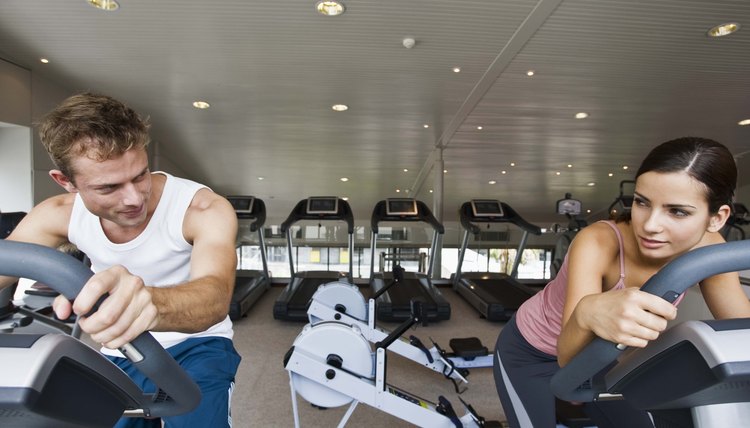Will Riding an Exercise Bike Strengthen My Knee?

An exercise bike is a bicycle that remains stationary as it is being peddled. It is an easy, elegant solution to the difficulty of taking a bike out to an area that is congested or unpleasant for bike riding or riding in inclement weather. An exercise bike is not just beneficial for becoming fit, however. It can also be used to strengthen the knee.
Anatomy
There are two major muscle groups that support and stabilize the knee: the quadriceps and hamstrings. The quadriceps group attaches to the front of the shin bone below the knee and controls the straightening of the knee and the movement of the kneecap. It's essential for standing, walking and running. The hamstrings group attaches to the back of the shin bone and is used to bend the knee. A number of other muscles such as the hip abductors also affect the knee. The major ligament in the region is called the anterior cruciate ligament; it's the most common place for a knee injury.
Low Impact Exercise
Compared to other exercises, cycling is a relatively healthy exercise for the knee. The motion is smooth, and the knee bears little of the actual weight; it doesn't have the same high impact effect as running or any sport in which running is critical. In addition, the resistance of the bike can be changed to allow the knee to do more or less work in accordance with how your knee feels in response to the exercise.
Benefits
According to the website Cartilage Health, stationary exercise bikes are used often for knee rehabilitation after knee injury or surgery and the management of chronic degenerative conditions such as osteoarthritis. Cycling can help with knee joint range of movement, knee joint stability and muscle strength. It can also reduce or eliminate pain. The cycling motion will nourish the anterior cruciate ligament and build the quadriceps.
Routine
For many people, a stationary exercise bike can be a cornerstone of an exercise routine. It also works wonderfully as a warm-up exercise. Five minutes on the bike will prepare your muscles for strenuous activity. By increasing the blood supply to the muscles of the knee, cycling helps to prevent injury during exercise.
Correct Form
You must set the saddle of the bike at a height that will not strain your knee or hip joints. The saddle is considered too high if your hips rock back and forth as you ride, which places stress on your hip joints. Your knee will also be completely straightened when the pedal is at its lowest point, which can strain the illotibial band and the anterior cruciate ligament in the knee. You should adjust your seat to a height that leaves your leg just slightly bent on the downstroke to the lowest pedal level.
Explore In Depth
References
- Lespasio MJ, Piuzzi NS, Husni ME, Muschler GF, Guarino A, Mont MA. Knee Osteoarthritis: A Primer. Perm J. 2017;21:16-183. doi:10.7812/TPP/16-183
- Kiapour AM, Murray MM. Basic science of anterior cruciate ligament injury and repair. Bone Joint Res. 2014;3(2):20-31. doi:10.1302/2046-3758.32.2000241
- Doral MN, Bilge O, Huri G, Turhan E, Verdonk R. Modern treatment of meniscal tears. EFORT Open Rev. 2018;3(5):260-268. doi:10.1302/2058-5241.3.170067
- Reinking MF. CURRENT CONCEPTS IN THE TREATMENT OF PATELLAR TENDINOPATHY. Int J Sports Phys Ther. 2016;11(6):854-866.
- Petersen W, Rembitzki I, Liebau C. Patellofemoral pain in athletes. Open Access J Sports Med. 2017;8:143-154. doi:10.2147/OAJSM.S133406
- Frush TJ, Noyes FR. Baker's Cyst: Diagnostic and Surgical Considerations. Sports Health. 2015;7(4):359-65. doi:10.1177/1941738113520130
- Huang YC, Yeh WL. Endoscopic treatment of prepatellar bursitis. Int Orthop. 2011;35(3):355-8. doi:10.1007/s00264-010-1033-5
- Beals C, Flanigan D. A Review of Treatments for Iliotibial Band Syndrome in the Athletic Population. J Sports Med (Hindawi Publ Corp). 2013;2013:367169. doi:10.1155/2013/367169
- Tsai CH, Hsu CJ, Hung CH, Hsu HC. Primary traumatic patellar dislocation. J Orthop Surg Res. 2012;7:21. doi:10.1186/1749-799X-7-21
- Ragab G, Elshahaly M, Bardin T. Gout: An old disease in new perspective - A review. J Adv Res. 2017;8(5):495-511. doi:10.1016/j.jare.2017.04.008
- Lee PYF, Nixion A, Chandratreya A, Murray JM. Synovial Plica Syndrome of the Knee: A Commonly Overlooked Cause of Anterior Knee Pain. Surg J (N Y). 2017;3(1):e9-e16. doi:10.1055/s-0037-1598047
- Vaishya R, Azizi AT, Agarwal AK, Vijay V. Apophysitis of the Tibial Tuberosity (Osgood-Schlatter Disease): A Review. Cureus. 2016;8(9):e780. doi:10.7759/cureus.780
- Zanon G, Di vico G, Marullo M. Osteochondritis dissecans of the knee. Joints. 2014;2(1):29-36.
- Hindle P, Davidson E, Biant LC. Septic arthritis of the knee: the use and effect of antibiotics prior to diagnostic aspiration. Ann R Coll Surg Engl. 2012;94(5):351-5. doi:10.1308/003588412X13171221591015
- Gwinner C, Märdian S, Schwabe P, Schaser KD, Krapohl BD, Jung TM. Current concepts review: Fractures of the patella. GMS Interdiscip Plast Reconstr Surg DGPW. 2016;5:Doc01. doi:10.3205/iprs000080
- Voskuil R, Evenski AJ, Montgomery C, Emory CL. Malignant Bone Tumors of the Knee: How to Identify and Treat. J Knee Surg. 2019;32(4):305-314. doi:10.1055/s-0038-1675828
- Gupte C, St mart JP. The acute swollen knee: diagnosis and management. J R Soc Med. 2013;106(7):259-68. doi:10.1177/0141076813482831
- American Academy of Orthopedic Surgeons. Unstable Kneecap.
- Bhatia D, Bejarano T, Novo M. Current interventions in the management of knee osteoarthritis. Journal of Pharmacy & Bioallied Sciences 2013 Jan-Mar;5(1):30-38. doi:%2010.4103/0975-7406.106561
- Bronstein RD, Schaffer JC. Physical Examination of the Knee: Meniscus, Cartilage, and Patellofemoral Conditions. J Am Acad Orthop Surg. 2017 May;25(5):365-374.
- Browne K, Kurtz CA. How to perform a comprehensive examination of the knee. JAAPA. 2009 Jun;22(6):20-25.
- Hergenroeder AC, Harvey BS. (2017). Osteochondritis dissecans (OCD): Clinical manifestations and diagnosis. Bachur RG, ed. UpToDate. Waltham, MA: UpToDate Inc.
